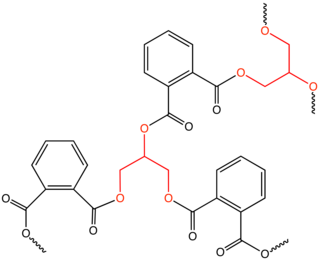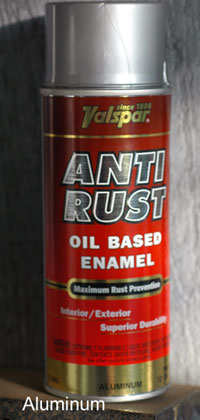Paint
Typically the term "enamel paint" is used to describe oil-based covering products, usually with a significant amount of gloss in them, however recently many latex or water-based paints have adopted the term as well. The term today means "hard surfaced paint" and usually is in reference to paint brands of higher quality, floor coatings of a high gloss finish, or spray paints. Most enamel paints are alkyd resin based. Some enamel paints have been made by adding varnish to oil-based paint.
Although "enamels" and "painted enamel" in art normally refer to vitreous enamel, in the 20th century some artists used commercial enamel paints in art, including Pablo Picasso (mixing it with oil paint), Hermann-Paul, Jackson Pollock, and Sidney Nolan. The Trial (1947) is one of a number of works by Nolan to use enamel paint, usually Ripolin, a commercial paint not intended for art, also Picasso's usual brand. [1] [2] Some "enamel paints" are now produced specifically for artists.
Enamels paints can also refer to nitrocellulose based paints, one of the first modern commercial paints of the 20th century. They have since been superseded by new synthetic coatings like alkyd, acrylic and vinyl, due to toxicity, safety, and conservation (tendency to age yellow) concerns. [3] In art has been used also by Pollock with the commercial paint named Duco. The artist experimented and created with many types of commercial or house paints during his career. [4] Other artists: "after discovering various types of industrial materials produced in the United States in the 1930s, Siqueiros' produced most of his easel works with uncommon materials which include Duco paint, a DuPont brand name for pyroxyline paint, a tough and resilient type of nitro-cellulose paint manufactured for the automotive industry". [5] Nitro-cellulose enamels are also commonly known as modern lacquers. Enamel paint comes in a variety of hues and can be custom blended to produce a particular tint. It is also available in water-based and solvent-based formulations, with solvent-based enamel being more prevalent in industrial applications. For the greatest results, use a high-quality brush, roller, or spray gun when applying enamel paint. When dried, enamel paint forms a durable, hard-wearing surface that resists chipping, fading, and discoloration, making it a great choice for a wide range of surfaces and applications. [6]

Acrylic paint is a fast-drying paint made of pigment suspended in acrylic polymer emulsion and plasticizers, silicone oils, defoamers, stabilizers, or metal soaps. Most acrylic paints are water-based, but become water-resistant when dry. Depending on how much the paint is diluted with water, or modified with acrylic gels, mediums, or pastes, the finished acrylic painting can resemble a watercolor, a gouache, or an oil painting, or have its own unique characteristics not attainable with other media.

Paint is a liquid pigment that, after applied to a solid material and allowed to dry, adds a film-like layer, in most cases to create an image, known as a painting. Paint can be made in many colors and types. Most paints are either oil-based or water-based, and each has distinct characteristics.

Varnish is a clear transparent hard protective coating or film. It is not to be confused with wood stain. It usually has a yellowish shade due to the manufacturing process and materials used, but it may also be pigmented as desired. It is sold commercially in various shades.

Lacquer is a type of hard and usually shiny coating or finish applied to materials such as wood or metal. It is most often made from resin extracted from trees and waxes and has been in use since antiquity.

Vitreous enamel, also called porcelain enamel, is a material made by fusing powdered glass to a substrate by firing, usually between 750 and 850 °C. The powder melts, flows, and then hardens to a smooth, durable vitreous coating. The word vitreous comes from the Latin vitreus, meaning "glassy".

A whiteboard is a glossy, usually white surface for making non-permanent markings. Whiteboards are analogous to blackboards, but with a smoother surface allowing for rapid marking and erasing of markings on their surface. The popularity of whiteboards increased rapidly in the mid-1990s and they have become a fixture in many offices, meeting rooms, school classrooms, public events and other work environments.
Water-miscible oil paint is oil paint either engineered or to which an emulsifier has been added, allowing it to be thinned and cleaned up with water. These paints make it possible to avoid using, or at least reduce volatile organic compounds such as turpentine that may be harmful if inhaled. Water-miscible oil paint can be mixed and applied using the same techniques as traditional oil-based paint, but while still wet it can be removed from brushes, palettes, and rags with ordinary soap and water. One of the ways its water solubility comes from is the use of an oil medium in which one end of the molecule has been engineered to be hydrophilic and thus bind loosely to water molecules, as in a solution. This type of paint is different to those that are engineered to enable cleaning of brushes and application equipment in water but are not in themselves water reducible.

Aerosol paint is paint that comes in a sealed, pressurized container and is released in an aerosol spray when a valve button is depressed. The propellant is what the container of pressurized gas is called. When the pressure holding the gas is released through the valve, the aerosol paint releases as a fine spray. Aerosol painting is one form of spray painting; it leaves a smooth, even coat, unlike many traditional rolled and brushed paints. Aerosol primer can be applied directly to bare metal and many plastics.

An alkyd is a polyester resin modified by the addition of fatty acids and other components. Alkyds are derived from polyols and organic acids including dicarboxylic acids or carboxylic acid anhydride and triglyceride oils. The term alkyd is a modification of the original name "alcid", reflecting the fact that they are derived from alcohol and organic acids. The inclusion of a fatty acid confers a tendency to form flexible coatings. Alkyds are used in paints, varnishes and in moulds for casting. They are the dominant resin or binder in most commercial oil-based coatings. Approximately 200,000 tons of alkyd resins are produced each year. The original alkyds were compounds of glycerol and phthalic acid sold under the name Glyptal. These were sold as substitutes for the darker-colored copal resins, thus creating alkyd varnishes that were much paler in colour. From these, the alkyds that are known today were developed.

Metallic paint, which may also called metal flake or polychromatic, is a type of paint that is most common on new automobiles, but is also used for other purposes. Metallic paint can reveal the contours of bodywork more than non-metallic, or "solid" paint. Close-up, the small metal flakes included in the paint create a sparkling effect mimicking a metal surface.
A glaze is a thin transparent or semi-transparent layer on a painting which modifies the appearance of the underlying paint layer. Glazes can change the chroma, value, hue and texture of a surface. Glazes consist of a great amount of binding medium in relation to a very small amount of pigment. Drying time will depend on the amount and type of paint medium used in the glaze. The medium, base, or vehicle is the mixture to which the dry pigment is added. Different media can increase or decrease the rate at which oil paints dry.

Automotive paint is paint used on automobiles for both protective and decorative purposes. Water-based acrylic polyurethane enamel paint is currently the most widely used paint for reasons including reducing paint's environmental impact.
An oil drying agent, also known as siccative, is a coordination compound that accelerates (catalyzes) the hardening of drying oils, often as they are used in oil-based paints. This so-called "drying" occurs through free-radical chemical crosslinking of the oils. The catalysts promote this free-radical autoxidation of the oils with air.
Rangsazi Iran - Iran Paint Manufacturing Company - شرکت رنگسازي ايران, was founded in 1939 as the first paint producer in Iran as well as the Middle East. Rangsazi Iran is currently the top producer in decorative and industrial paints within the country in terms of volume of sales and quality.
Drip painting is a form of abstract art in which paint is dripped or poured on to the canvas. This style of action painting was experimented with in the first half of the twentieth century by such artists as Francis Picabia, André Masson and Max Ernst, who employed drip painting in his works The Bewildered Planet, and Young Man Intrigued by the Flight of a Non-Euclidean Fly (1942). Ernst used the novel means of painting Lissajous figures by swinging a punctured bucket of paint over a horizontal canvas.
Industrial porcelain enamel is the use of porcelain enamel for industrial, rather than artistic, applications. Porcelain enamel, a thin layer of ceramic or glass applied to a substrate of metal, is used to protect surfaces from chemical attack and physical damage, modify the structural characteristics of the substrate, and improve the appearance of the product.

The conservation and restoration of paintings is carried out by professional painting conservators. Paintings cover a wide range of various mediums, materials, and their supports. Painting types include fine art to decorative and functional objects spanning from acrylics, frescoes, and oil paint on various surfaces, egg tempera on panels and canvas, lacquer painting, water color and more. Knowing the materials of any given painting and its support allows for the proper restoration and conservation practices. All components of a painting will react to its environment differently, and impact the artwork as a whole. These material components along with collections care will determine the longevity of a painting. The first steps to conservation and restoration is preventive conservation followed by active restoration with the artist's intent in mind.

An oil base or oil pedestal is a water, dirt and fat repellent paint, which is applied directly as a coating on the rough plaster to protect it. Mostly it consists of a coating of paint, which is based on alkyd resin and is often applied in staircases, but also in kitchens and bathrooms of old buildings. It is sometimes found in heavy traffic hallways.
Waterborne resins are sometimes called water-based resins. They are resins or polymeric resins that use water as the carrying medium as opposed to solvent or solvent-less. Resins are used in the production of coatings, adhesives, sealants, elastomers and composite materials. When the phrase waterborne resin is used, it usually describes all resins which have water as the main carrying solvent. The resin could be water-soluble, water reducible or water dispersed.












